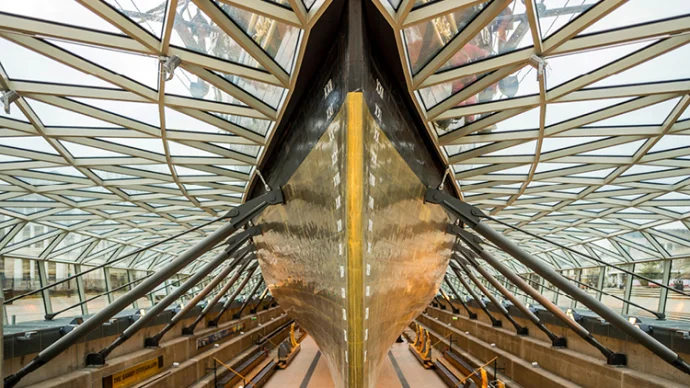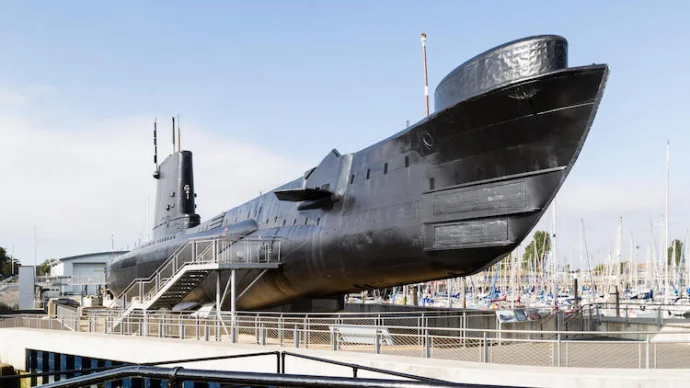About Royal Museums Greenwich
Royal Museums Greenwich, part of Maritime Greenwich World Heritage Site, is made up of the National Maritime Museum, Cutty Sark, the Royal Observatory and the Queen’s House.
Royal Museums Greenwich history
Greenwich has long had associations with seafaring and navigation. It is perhaps most famous for giving its name to the Greenwich Meridian (0° longitude) and Greenwich Mean Time.
Greenwich’s association with seafaring can be traced all the way back to when the Romans landed there in the first century AD. Remains of a Roman Temple were excavated in the late 20th century near the centre of Greenwich Park, further highlighting the strategical significance of the area.
In the 15th century, the town became the site of a royal palace, the Palace of Placentia, and was the birthplace of many royal and iconic historical figures, including Henry VIII and Elizabeth I. Both Tudor monarchs were known for their obsessions of building a strong Navy to protect Britain and expand its influence across the globe. Henry VIII officially founded the Royal Navy in 1546.
Other royal figures, such as Charles II, founded the Royal Observatory in Greenwich in 1675 for “finding the longitude of places”. The home of Greenwich Mean Time and the Prime Meridian since 1884, Greenwich has long been a centre for astronomical study, while navigators across the world have set their clocks according to its time of day.
In 1616, Inigo Jones was commissioned by James I’s wife Anne of Denmark to build a house in Greenwich. This was supposedly as an apology present from James to Anne after he swore in front of her (she had accidentally killed one of his dogs during a hunt). The House was finished in 1636, long after Anne died, under the instruction of Charles I’s wife Henrietta Maria. It was used by the royal family until George III donated it to a charity for orphans of sailors in 1805. In 1934, the House was taken over by the National Maritime Museum.
Buildings originally constructed to serve as the Royal Hospital for Seamen at Greenwich, now generally known as Greenwich Hospital (designed by Christopher Wren, and built between 1696 and 1712) became home to the Royal Naval College in 1873, dubbed one of the “finest and most dramatically sited architectural and landscape ensemble in the British Isles”. The Old Royal Naval College is open to the public, with many being captivated by the grand painted hall.
The National Maritime Museum, formerly opened by King George VI in 1937, serves to recognise and exhibit Britain’s inextricable and historical connection with the sea and navigation through a wide variety of impressive displays and exhilarating exhibitions.
Since the 1950s, Cutty Sark has been in a dry dock in Greenwich and was opened to the public in 1957.
The Museums today
Today, Royal Museums Greenwich has some of the most important holdings in the world on the history of Britain at sea.
Its collection comprises of more than two million items, including maritime art (both British and 17th-century Dutch), cartography, manuscripts including official public records, ship models and plans, scientific and navigational instruments, instruments for time-keeping and astronomy (based at the Observatory). Its holdings also include iconic and priceless artefacts relating to Vice-Admiral Horatio Nelson and the voyages of Captain James Cook.
The Queen’s House has a remarkable art collection including work by Turner, Reynolds and Hogarth. The famous Armada portrait of Elizabeth I was purchased by RMG in 2016 and can be seen on display in the Queen’s House.
The National Maritime Museum offers a number of unique and unrivalled permanent exhibitions, as well as a welcomed variety of temporary exhibitions. Visitors can get up close to the actual uniform Admiral Nelson wore when he was fatally wounded at the Battle of Trafalgar, or witness the exact coconut cup that William Bligh ate his food ration from when cast adrift from HMS Bounty in 1789. It also holds a renowned exhibition on Britain’s involvement in the transatlantic slave trade throughout the 17th, 18th and 19th centuries, containing key artifacts relating to the trade and abolition such as first edition portraits of abolitionist such as Olaudah Equiano and Ignatius Sancho, or a real York Election ticket of 1807, used to vote for William Wilberforce, inscribed with the words, ‘HUMANITY IS THE CAUSE OF THE PEOPLE’.
Walking up the hill behind the National Maritime Museum, visitors can explore the Royal Observatory and learn more about the history of time and navigation.
Cutty Sark is open to visitors to explore the decks of one of the world’s most famous historical ships. Through interesting interpretation and exhibitions, visitors can learn of Cutty Sark‘s career as a tea clipper and her voyages across oceans.
Getting to Royal Museums Greenwich
You can get to the National Maritime Museum in Greenwich by road, rail or river. We’re just 8 minutes from central London by rail, 20 minutes by DLR, or make the journey part of the fun and arrive by boat.
For Greenwich town centre, the nearest stations are Cutty Sark DLR, Greenwich rail station, Maze Hill rail station or Greenwich Pier. If travelling by bus, routes 129, 177, 180, 188, 286, 386 and N1 all stop near the National Maritime Museum.
All of the museums in Greenwich are within easy walking distance of each other, and only a short walk from the stations, within historic Greenwich and Royal Greenwich Park.
For those with disabilities travelling by car, there are limited pre-booked spaces available for in the Museum car park. Alternative parking in Greenwich is limited, particularly at weekends. There are off-street pay-and-display car parks in Greenwich Park (run by the Royal Parks; 250 spaces, maximum 4 hours).
Featured In

Henry VIII Sites to Visit
Follow in the footsteps of King Henry VIII and explore the historic sites across Britain that shaped his life, reign and many marriages.

Historic UK Ships and Boats to Visit
Explore the UK's maritime and naval heritage through these 15 remarkable vessels.

World Maritime Museums
Explore the global history of seafaring and the seas at these fascinating maritime museums.

London War Museums
From the Royal Air Force Museum to the Household Cavalry Museum, these London institutions explore the history of Britain's armed forces.

English War Museums
Discover the history of military life in Britain and beyond at these 10 important war museums across England.

Historic Slavery Sites in the United Kingdom
Discover crucial histories of slavery at these sites around the UK, from the International Slavery Museum at Royal Albert Dock in Liverpool to the Buxton Memorial Fountain outside the Palace of Westminster.


























